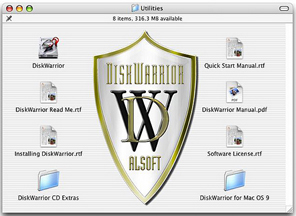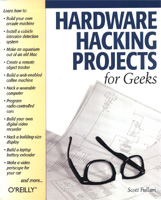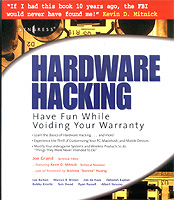
eXtensions
|
OSX fixes and Hardware Hacks: Review of Disk Warrior 3.1 and two books on hardware hacking |
My iMac did not settle down with a new battery installation. Aged two, and after much abuse, I wondered if it were about to expire: a shame. One of the best computers I have owned.
I reinstalled OSX using a procedure called "archive and install." The old OS is put to one side and a new one installed: user settings intact. As I was using 10.3.2, it meant going back to 10.3 and updating.
All went well until I got back to 10.3.2 and the multi-language box came on telling me to shut down and start the computer again: a kernel panic. If I started in safe mode (shift key pressed) it booted. If I then restarted normally, OSX ran, but would quit randomly.
Starting up in single-user mode (Command + S) and running a file system check, produced the message, "we are hanging here." Starting up with installation disks (these have the disk utility tools) also stopped the computer.
Analysis: the safe mode startup missed the checks; the vanilla start used the journalled system; but the single user and the disk startups ran the full check. I did what sensible people do: I shut down and went to bed.
The next morning, I took the iMac to my office where it started first time. Once I had backed up data onto the G4, I ran all checks again: zero problems. The difference was the heat. The office is air-conditioned, my home is not.
The previous day's usage, before problems (iTunes, Internet, graphics work and Neverwinter Nights), had been in high temperatures: all pushing the iMac past what it was prepared to do. Interrruptions had destabilised the system.
I realised that my version of Disk Warrior was out of date. The latest version (3.0.1) arrived the day before Songkran. Perfect: three days behind closed doors.

Inserting the bootable disk I restarted with the C-key pressed. The CDROM is painfully slow as it checks the entire system. The "Repair" is faster and, while some tidying up was needed, there were no defects.

|

|
The process leads users by the hand. A list of problem files is shown, as well as current and suggested directory structures. Nothing is changed until you press, "Accept". With insufficient contiguous space on my hard disk, there was a slight risk of data loss. I could have taken time to delete files, but took a gamble.
After restarting, I installed Disk Warrior. All I can do on the startup disk is to create a graph of the directory and repair an external disk.
On top of regular maintenance and checks, Disk Warrior gives users another level of insurance and peace of mind.
Fullam, Scott. Hardware Hacking Projects for Geeks. O'Reilly: Sebastopol, CA. US$29.95. ISBN 0-596-00314-5
Grand, Joe, Ed.. Hardware Hacking: Have Fun While Voiding Your Warranty. Syngress; Rockland, MA. US$39.95. ISBN 1-932266-83-6

|

|
As a child in England, I had a popular (and necesary) book of "Things to Do on a Rainy Day". Two books that came my way recently, are like super versions of this and would work well either for a hobbyist or for student projects.
On the face of it, both of these books, particularly that edited by Joe Grand, appear flippant but there is some serious engineering involved here.
Although they have the same basic purpose -- back to the basics (and enjoyable) engineering -- there are few similarities. Hardware Hacking Projects for Geeks is a slight misnomer as the approach is to take slightly-offbeat projects and treat them as serious -- but fun -- undertakings.
Of the two, "Geeks" has a clearer layout and slightly better images. It is also slightly less cluttered and particularly well-organised, which may suit an educational environment better.
After an introductory chapter, there are fourteen different projects. The first five are graded easy; the last nine (with a section on advanced tools and techniques) include two Internet projects: a toaster and coffee-maker.
Fullam sets out the ideas for each project, shows how to adapt hardware, and provides a list of materials. Where needed, clear circuit diagrams are given. I particularly liked the Mac Aquarium -- expensive to buy -- the camera-periscope for a car, and the remote object tracker.
There is a slight overlap with the Grand-edited book in the section on 802.11b antennas. This idea is covered in so many sources currently: it would be a surprise if it were not in both.
Projects in the Grand book involve such diverse hardware as Atari, Playstation, Mac and PC computers, iPod, Palm, and Nokia phone hacks. This book contains also some excellent introductory sections on electrical engineering and (at the end) sections on operating systems and a chapter called Coding 101.
Circuit diagrams are also provided here. In line with the irreverent style, the writing here is a little more chatty than in the "Geeks" book. With Kevin Mitnick listed as Technical Reviewer, this is a book whose users will push the envelope.

For further information, e-mail to Graham K. Rogers.
Back to
eXtensions
To
eXtensions: Book Reviews
To
eXtensions: Year One
Back to homepage